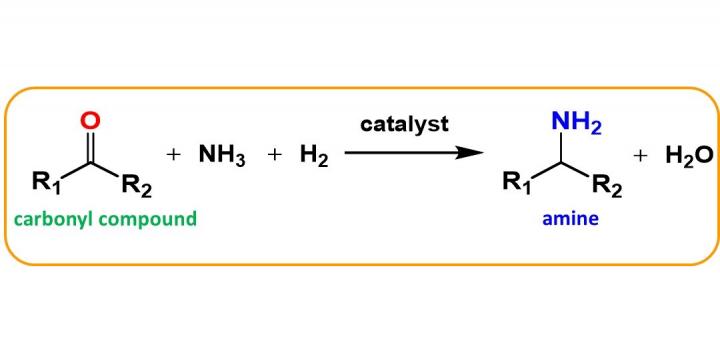A game-changer for the reductive amination of carbonyl compounds: Researchers from Osaka University develop an air-stable reusable metal-phosphide catalyst for the reductive amination of carbonyl compounds

Credit: Osaka University
Osaka, Japan – Catalysts are crucial to making industrial processes viable. However, many of the non-precious metal catalysts used for synthesis have low activity, are difficult to handle, and/or require harsh reaction conditions. Osaka University researchers have developed a single-crystal cobalt phosphide nanorod catalyst that overcomes several of the limitations of conventional cobalt catalysts. Their findings were published in JACS Au.
Reductive amination is an important chemical reaction that is used to convert carbonyl compounds into amines. It is a key step in the production of many materials such as polymers, dyes, and pharmaceuticals, and is attractive because the reagents are cost effective and widely available, and the main byproduct is water.
The catalysts currently used for reductive amination are generally non-precious metal catalysts such as cobalt and nickel sponges. However, they are highly sensitive to air, and this makes them difficult to handle without deactivation. They also require harsh reactions conditions, such as high H2 pressures, which increases energy and infrastructure costs. Therefore, the development of a new air-stable and highly active catalyst is highly desired.
The researchers prepared a single-crystal cobalt phosphide nanorod catalyst for the reductive amination of carbonyl compounds. The introduction of phosphorus into the cobalt–a method called “phosphorus-alloying”–makes the cobalt active and stable in air. It also creates well-defined active sites in the crystal structure, which lead to more selective reactions compared with those on conventional catalysts.
“Our nanorod is the first metal-phosphide catalyst that has been used for reductive amination, as well as being the first cobalt catalyst that is effective at atmospheric pressure,” study first author Min Sheng explains. “Furthermore, our catalyst showed the highest turnover number of all homogeneous and heterogenous non-precious metal catalysts tested for the same reaction.”
The nanorod catalyst retains the high activity after 4 uses, which demonstrates that it is a viable alternative for use in processes requiring high throughput.
“We expect our nanorod catalyst to make a significant contribution to the cost and energy efficient production of amines,” says study corresponding author Takato Mitsudome. “But beyond this, we believe phosphorus-alloying has the potential to enhance the catalysis for many other organic reactions, leading to greener and more sustainable processes that improve productivity, conserve energy resources, and avoid the reliance on hazardous compounds while protecting our environment.”
###
The article, “Single-crystal cobalt phosphide nanorods as a high-performance catalyst for reductive amination of carbonyl compounds,” was published in JACS Au at DOI: https:/
About Osaka University
Osaka University was founded in 1931 as one of the seven imperial universities of Japan and is now one of Japan’s leading comprehensive universities with a broad disciplinary spectrum. This strength is coupled with a singular drive for innovation that extends throughout the scientific process, from fundamental research to the creation of applied technology with positive economic impacts. Its commitment to innovation has been recognized in Japan and around the world, being named Japan’s most innovative university in 2015 (Reuters 2015 Top 100) and one of the most innovative institutions in the world in 2017 (Innovative Universities and the Nature Index Innovation 2017). Now, Osaka University is leveraging its role as a Designated National University Corporation selected by the Ministry of Education, Culture, Sports, Science and Technology to contribute to innovation for human welfare, sustainable development of society, and social transformation.
Website: https:/
Media Contact
Saori Obayashi
[email protected]
Related Journal Article
http://dx.




